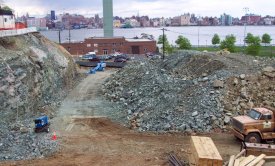 With no dumping allowed in the Meadowlands, serpentine rock accumulates at Castle Point in Hoboken, uncovered.
With no dumping allowed in the Meadowlands, serpentine rock accumulates at Castle Point in Hoboken, uncovered.(May 2002)
On April 24, 2002, after learning that an estimated 30,000 cubic yards of rock dumped in the Meadowlands contained asbestos, the New Jersey Meadowlands Commission ordered an end to the dumping and demanded its removal. Subsequently, NJMC hired an engineering firm to test for the asbestos content of this mineral which has been excavated by Stevens Institute of Technology from its campus to make way for an 800-car parking garage. On May 9, 2002, this engineering firm, H2M Group, reported levels of asbestos far higher than previously claimed by Stevens Institute. More alarming, however, are 10% levels of actinolite found in two of the test samples. Actinolite is a rarer form of asbestos with sharp, needle-like fibers that make it a potent carcinogen.
Since the public first learned in early April about the presence of asbestos, Stevens Institute has repeatedly stated that only trace amounts were present in this rock and no health hazard has been posed. The test results by H2M Group directly contradict Stevens’ claim. The tests conducted this month show three samples of the serpentine rock containing 15% asbestos. Two of these samples were comprised of the 10% actinolite and 5% chrysotile. Another sample was found to contain 5% chrysotile. Two additional samples, using a more reliable testing method, Transmission Electron Microscopy, also recorded significant levels of asbestos.
Asbestos is one of a handful of substances conclusively proven to be a human carcinogen. Actinolite and other forms of asbestos in the amphobile group are considered especially dangerous because the fibers are more difficult for the lungs to expel. The amphobile family of asbestos is also more likely to become airborne than the chrysotile asbestos. Asbestos becomes a health hazard when it becomes lodged in the lungs. The major health risks linked to asbestos are asbestosis, a scarring of the lungs; mesothelioma, a cancer of the lung and chest linings; and lung cancer.
Beginning on March 11, 2002, a caravan of trucks hauling the serpentine rock from Castle Point in Hoboken unloaded at a property owned by Empire, Lmt. in Carlstadt, New Jersey. The Dinallo family who owns Empire, Lmt. are also the owners of Terminal Construction Company, the general contractor excavating the rock at the campus of Stevens Institute. On July 24, 2000, NJMC granted a permit to Empire, Lmt. to dump clean fill on their Carlstadt land.
Also on March 11 at the other end of this operation in Hoboken at the Castle Point site, Stevens Institute began drilling, blasting and excavating, sending clouds of dust into the air. For the first five weeks of operation, no precautions were taken such as hydrating the site to control the dust. For the entire operation, the workers have gone unprotected, wearing no dust masks and utilizing no decontamination procedures.
On April 10, after learning that serpentine rock contains asbestos, the Fund for a Better Waterfront, a local civic group, filed a complaint with the Hoboken Board of Health. For years, Stevens Institute administrators knew that asbestos was in the rock but kept this information to themselves, failing to notify the public or any government officials. On May 2, an attorney from Windels Marx Lane & Mittendorf, on behalf of Stevens Institute, sent a letter to foundations that have provided financial support to the Fund for a Better Waterfront, threatening to sue the group for libel. This letter implied that this group was a “cult” and has used scare tactics to frighten the public regarding the asbestos issue.
The drilling conducted by Terminal Construction Company at the Castle Point site creates piles of fine dust. The explosive devices are then placed into the holes and detonated, sending this dust into the air. In addition, the report prepared for the New Jersey Meadowlands Commission indicated that the asbestos fibers tend to grow in the fault lines of the serpentine rock. Thus, during the blasting, the rock breaks apart at these planes, potentially sending more asbestos into the air.
A recent report written by Jeff Faria for Stevens Institute of Technology, seeks to reassure the public about the threat in Hoboken by arguing that chrysotile asbestos is more easily expelled from the lungs: “For amosite and crocidolite, estimated clearance half-times are measured in years to decades, whereas for chrysotile . . . the vast majority of fibers are cleared within months.” The National Institute of Occupational Safety and Health (NIOSH), however, contends “there is no safe airborne fiber concentration for asbestos.” The federal government, through the EPA, has also taken the position that all forms of airborne asbestos, including chrysotile, are considered hazardous and no distinction is made between the “good and bad” asbestos. The report from Faria was written before the rock testing by the NJMC identified the 10% actinolite levels in the two samples.
FBW News Archive
